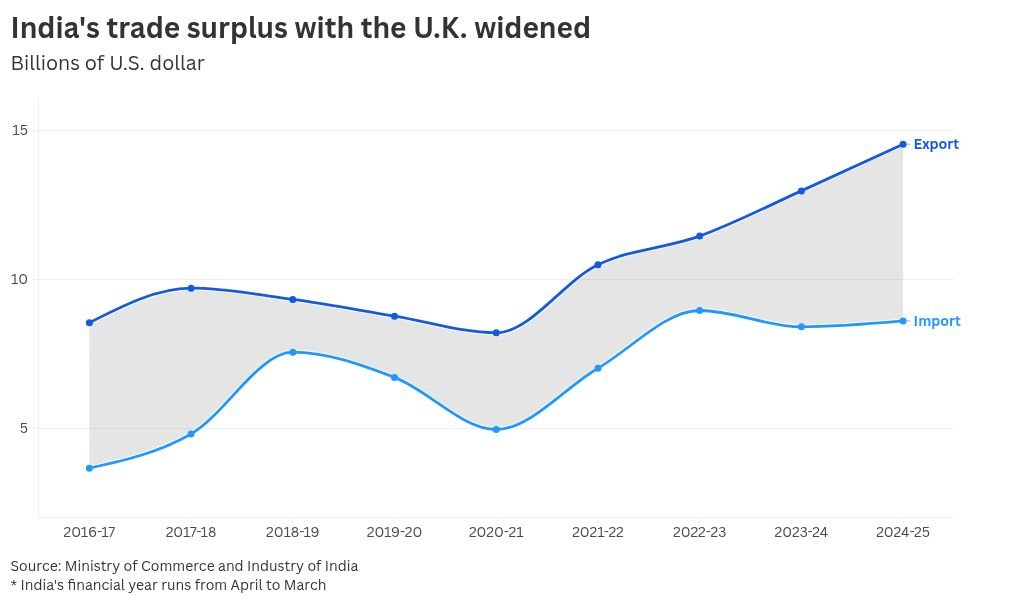Historic Trade Agreement Between the UK and India
Overview of the Agreement
The trade relationship between the United Kingdom and India is set to experience significant growth as a result of a newly signed free trade agreement (FTA). This landmark pact, which leaders from both nations have described as a "historic" achievement, aims to enhance bilateral trade by over $34 billion annually in the long term. The agreement was formalized recently in the presence of UK Prime Minister Keir Starmer and Indian Prime Minister Narendra Modi.
The FTA notably reduces tariffs on an array of products, including textiles, automobiles, and beverages. The negotiations for this pact began three years ago and entailed complicated discussions over tariffs, visa regulations, and taxation issues. The urgency to finalize the agreement intensified amid rising tariff threats from the U.S., leading both nations to expedite their negotiations.
Trade Projections and Economic Benefits
Experts estimate that this agreement will expand trade between the UK and India by approximately 25.5 billion pounds annually by 2040. In fact, trade in goods and services between the two nations already surpassed 40 billion pounds in 2024.
Prime Minister Starmer emphasized the vast benefits this deal will bring, asserting that it will enhance wages, elevate living standards, and decrease consumer prices. Modi echoed these sentiments, referring to the agreement as a "blueprint for our shared prosperity," pointing out that Indian sectors like textiles, jewelry, and agricultural products will receive greater access to the UK market.
According to the terms of this agreement, 92% of goods exported from the UK to India will either see tariffs entirely removed or significantly reduced. Meanwhile, about 99% of Indian exports to the UK will also be tariff-free.
Tariff Reductions Detailed
The UK government anticipates a notable reduction in the average tariffs on its exports to India, decreasing from 15% to as low as 3%. However, both parliaments will need to ratify the agreement, which could take several months.
In addition to tariff reductions, this deal provides exemptions for Indian temporary workers in the UK, relieving them and their employers from paying social security contributions for three years. Notably, tariffs on UK spirits like scotch and gin are poised to decrease from 150% to 75%, with the aim of further reduction to 40% over the next decade. For the auto industry, tariffs will drop to 10% within five years, down from the current maximum rate of 110%.
Previously, UK goods faced an average tariff of 14.6% in India, while Indian goods encountered a tariff of 4.2%. This agreement marks one of the first trade pacts India has signed with a developed economy, highlighting its strategic significance.
Strategic Implications of the Agreement
Analysts believe that this trade deal not only bolsters the UK and India but also empowers them in their negotiations with other global trade partners, especially the U.S. The benefits of the UK-India agreement could serve as crucial leverage against the United States in their ongoing discussions.
This FTA may contribute an additional 4.8 billion pounds ($6.5 billion) to the UK economy each year, which stands at a gross domestic product of 2.85 trillion pounds as of 2024. For India, the trade agreement is seen as a stepping stone in its ongoing talks with other advanced economies, giving the nation a stronger position in future negotiations.
Experts suggest that the deal signals to Western nations that India is ready to engage in trade on its own terms. New Delhi is racing against time to finalize a separate agreement with the U.S. before tariffs are set to increase on August 1, making this trade pact especially timely.
Conclusion
This newly signed trade agreement between the UK and India represents a crucial development in the economic landscapes of both nations. Through substantial tariff reductions and improved access to each other’s markets, this deal sets the stage for a stronger economic partnership that could yield significant benefits for businesses and consumers on both sides.
